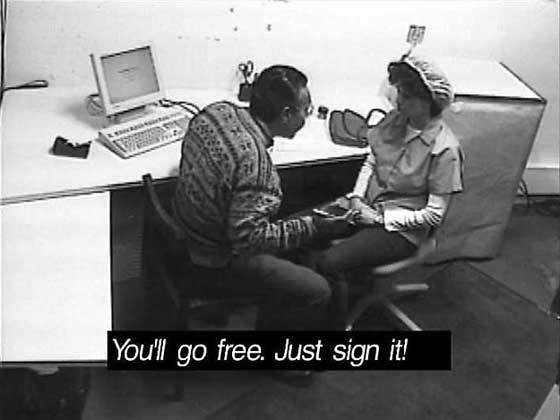CUBA
"DOLORES FROM 10 TO 10", 2002
(Video installation with multiple CCTV monitors | Black and white)
ARTIST'S MATERIAL:
[ENGLISH]
In the summer of 1993, on a research trip to Tijuana, Mexico, I met Delfina Rodriguez, a maquiladora worker who had been accused by her employer of trying to start a union in the plant. To coerce her into resigning, her manager had locked her in a room without food, water, bathroom or phone for twelve hours. She had signed a letter of resignation under duress and then, once she was released, she sued her former employer for violation of her civil rights. Her boss told the judge that she was insane, that nothing had happened and that she had no proof. Her co-workers were afraid to testify on her behalf. I was convinced that there must have been surveillance cameras recording what happened to her during her internment. Dolores from 10 to 10 is my interpretation of what the cameras saw.
[CURATORSHIP TXT EXTRACT]
Dolores de 10 às 10 (2002) re-assumes elements of Marquez’s work, such as re-enactment, confinement and political violence against the bodies. However in this video-installation by Cuban artist Coco Fusco the “prison” is the factory. This piece is the result of research by the artist in a “Maquiladora”1, known for disrespecting workers rights, located in Tijuana, Mexico. The city is on the border with the USA, a zone under strong surveillance, including video-monitoring. There are strict restrictions on the movement of Mexican citizens, but the same cannot be said about the industrial products assembled in the “Maquiladoras”. In this installation Fusco invests in the reconstitution of CCTV footage, re-enacting facts that happened to Delfina Rodriguez, “a maquiladora worker who had been accused by her employer of trying to start a union in the plant. To coerce her into resigning, her manager had locked her in a room without food, water, bathroom or phone for twelve hours.”2 She tried to sue her former employer for violation of her civil rights, but could not prove what she had passed through. In this context the artist re-creates images that CCTV could have recorded. The installation produces, thus, a “fictional proof” of her internment, attesting at the same time the fictional nature of any proof and subverting the visual hierarchy in which CCTV is usually included.
[CURADORIA TXT TRECHO]
Dolores de 10 às 10 (2002) retoma elementos de re-encenação, confinamento e violência política sobre os corpos, presentes na obra de Marquez. Mas neste trabalho da cubana Coco Fusco, a “prisão” é a fábrica. Trata-se de uma video-instalação resultante da pesquisa realizada pela artista em 1993 numa fábrica “maquiladora”, conhecida por desrespeitar os direitos trabalhistas, situada em Tijuana, cidade mexicana situada na fronteira com os EUA. Zona de disputa fortemente vigiada, inclusive por videomonitoramento, a fronteira entre os dois países impõe restrições ao trânsito de cidadãos mexicanos, mas o mesmo não se pode dizer dos produtos industrializados montados nas “maquiladoras”.1 Nesta obra, Fusco empenha-se em reconstituir, em uma encenação para CFTV, o fato ocorrido com Delfina Rodriguez, que por tentar organizar um sindicato na “maquiladora” onde trabalhava foi confinada por 12 horas em um cômodo na fábrica e forçada a assinar sua demissão sob coerção e constrangimentos físicos e psicológicos, privada de alimentação, água, banheiro e comunicação. Ao entrar na justiça contra o empregador, a operária não conseguiu provar os maus tratos e abusos sofridos. É neste contexto que a artista realiza uma obra onde recria as imagens que um circuito fechado de vídeo poderia ter registrado. O vídeo produz, assim, uma “prova fictícia” do acontecimento, atestando ao mesmo tempo o caráter ficcional de toda prova e subvertendo a hierarquia visual na qual o dispositivo de vídeo-vigilância usualmente se insere.
BIO
Coco Fusco is a New York-based interdisciplinary artist, writer and Director of Intermedia Initiatives at Parsons The New School for Design. She has performed, lectured, exhibited and curated around the world since 1988. She is a recipient of a 2003 Herb Alpert Award in the Arts. Fusco's performances and videos have been included two Whitney Biennials (2008 and 1993), the Sydney Biennale, The Johannesburg Biennial, The Kwangju Biennale, The Shanghai Biennale, InSite O5, Transmediale, The London International Theatre Festival, VideoBrasil and Performa05. She is the author of English is Broken Here: Notes on Cultural Fusion in the Americas (1995) and The Bodies that Were Not Ours and Other Writings(2001), and A Field Guide for Female Interrogators (2008). She is also the editor ofCorpus Delecti: Performance Art of the Americas (1999) and Only Skin Deep: Changing Visions of the American Self (2003).
Fusco’s work combine electronic media and performance in a variety of formats, from staged multi-media performances incorporating large scale projections and closed circuit television to live performances streamed to the internet that invite audiences to chart the course of action through chat interaction. Her most recent work deals with the role of female interrogators in the War on Terror. Those works include Operation Atropos (a film about interrogation training), and A Room of One’s Own (a monologue about female interrogators). Fusco is currently developing a new performance that explores the “Black Codes” that were established in the Americas after slavery for the 2010 World Congress of the International Drama/Theatre Education Association in Brazil. She is also researching a new project on the experience of incarceration in the United States.
